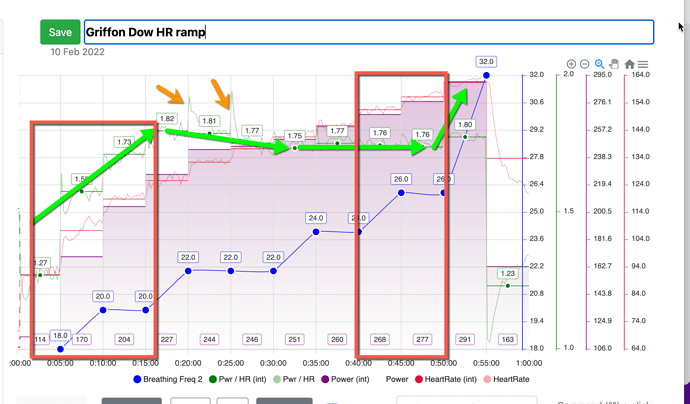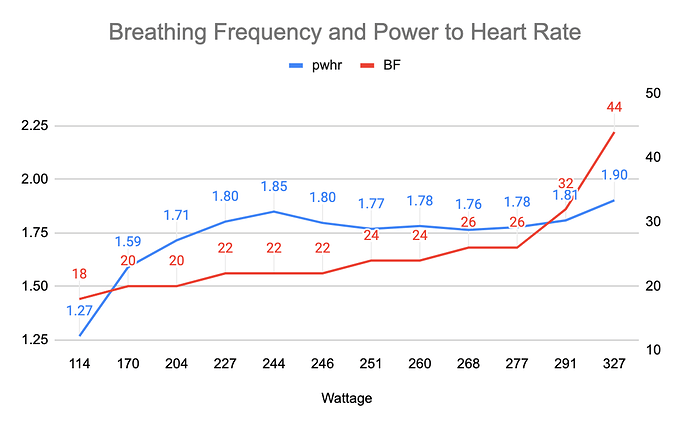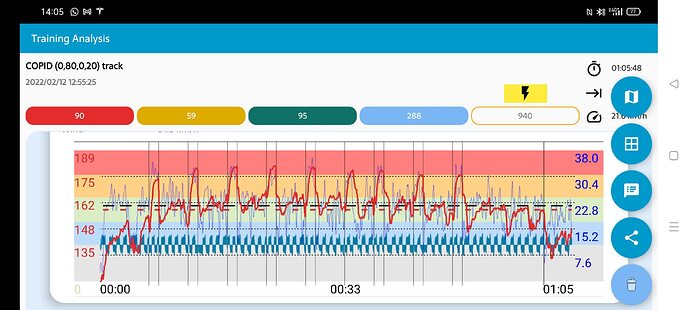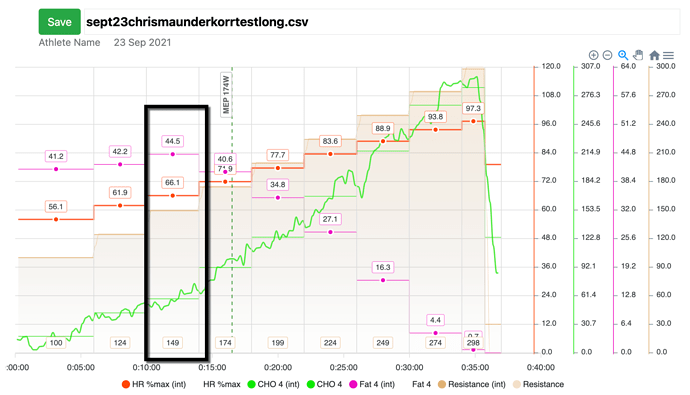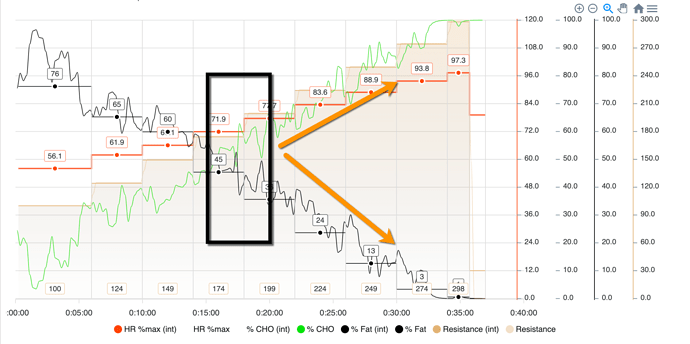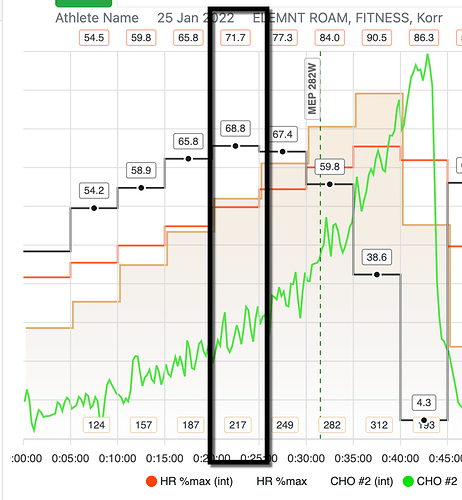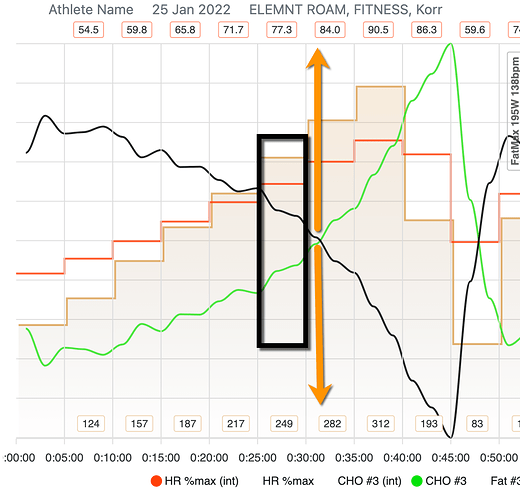No problem good luck with your training.
Hi Steve,
I did an 11 step test today to try to really refine this curve for you.
Below are the average power - avg HR - #breathes during the last 20" of each step. Each step was 5’
114 - 90 - 4.5
170 - 107 - 5
204 - 119 - 5
227 - 126 - 5.5
244 - 132 - 5.5
246 - 137 - 5.5
251 - 142 -6
260 - 146 - 6.0
268 - 152 - 6.5
277 - 156 -6.5
291 - 161 - 8
327 - 172 - 11 (taken from test done last Saturday)
Look forward to seeing the analysis, thanks for your time! (You also have access to my TP to see the actual data)
Hello @gdow
Below is your test graphed.
The two steps with the orange arrows you pushed a little hard to get the heart rate to move, but I still think we have something here.
Endurance training ok up to 205 watts, in the 170 to 205 watt range. This is also the first respiratory change, with the next noticeable one being at end of 277 watt stage.
From this I would say threshold is right around 275-280w. So training just before this at 265-270w.
For Tempo I think working in those three steps 227-246w.
What is your highest heart rate in last year?
Thanks Steve.
Endurance being 170-205 seems quite accurate and the go to all day pace (4+ hours). I would also consider 246 the upper end of easy and the 227-246 range where I often try to do a lot of my Z2 rides if my legs and myself aren’t too tired.
275-280 would definitely be the 1’ power, might be able to squeeze out a few more watts on a good day. Doing threshold workouts at 265-270 would result in pretty long intervals. For example I have planned 3X20’@261w w/ 5’ planned this weekend and it should be hard, but manageable, and don’t expect much HR drift. Last Saturday immediately following the initial HR step test I did 2X20’@260/248w. I think the 5’ at 327 during the last step took a bit out of the legs leaving me a little tired on the second interval and not willing to push the intended 260w. HR for those were 156 and 154. I did those thinking they were close to SS efforts in preparation for an Olympic Triathlon I have in 3 weeks (race pace). I followed that up with 3X12’@292 and 156,159 &160 HR on Tuesday. I saw that as a good threshold session.
I saw 193 once last year, and 190 twice. Neither were efforts that were consciously made seeking a max HR.
Hi,
This test works for some, maybe around 75% of the people I try it with, but still Inscyd, moxy, met cart testing, lactate are the only way to really define these places.
It does appear you have a pretty solid aerobic system so this would affect the test more so than others.
I graphed the last part of your test wrong, doesn’t change anything from my perspective.
It sounds like you have a good handle on things. I do very little threshold training with my athletes so I am not great in this world to converse, I do a lot of endurance/tempo and max efforts.
Looks like those 292w intervals had decoupling of just under 5% which I would say is about right. When I do use these types of intervals I look for around 7-8% to start, and watch for improvement down to around 3-5% then either switch the training, or make the intervals longer, or harder.
All the best in that race!
I was wondering…if you had access to both lactate threshold lab testing (at local University) and INSCYD testing (via Fast Talk), but you could only choose 1…what should I pick?
I know the 2 tests will provide different results and perhaps the answer to the question is that it depends on what my goals are and how I plan to use the results to improve my training. But would love to hear what the smarties think…please and thank you!
Inscyd Test and buy a Moxy Monitor
Hi Steve,
I have since gone down the Fat Max rabbit hole and as I train for an Ironman 70.3 see it as something that would be very beneficial. Interesting that it seems to be a sweet spot approach compared to the popular polarized training discussed about here.
You’re recommending to ride at 82% of max heart rate would be 158BPM which was 277 watts during the HR step test. However I also maintained 156,159, 160 HR during 3@12’ AT 291 watts a few days later. I’m thinking my HR may be suppressed from training?
82% HR max is then prescribed as the governor for the recommended tempo workouts. The step test found a tempo zone to be approx 227-246 watts however, the corresponding HR for that power was 126-137BPM? 3X20’@227-246 would be what I would consider upper end of an easy/moderate effort however, it would likely take 1.5-2+ hours of continuous riding before it would hit the ceiling of 158 BPM. It seems like the better way to go about it and not burn myself out would be to block days using the power ranges you gave, but not sure. This assumption is based off of RPE.
I’m guessing you would really want to identify blood lactate levels? Although I would again ask the same question of would the desired lactate levels be closer to 82% HR max or tempo power as there seems to be a disparity? Regardless it would be above LT1?
I saw your most recent recommendation here was to use the Inscyd test over blood lactate. I was quite interested in getting a blood lactate monitor to allow myself to do tests more often, ensuring each workout is staying within the proper zones. Would an improvement in Fat Max show on lactate tests? Or it has to be through metabolic testing which Inscyd provides? I’m guessing Inscyd was recommended as you aren’t as concerned with weekly testing during workouts as you are with just getting the initial zones dialed in? Would you opinion change for a triathlete looking to use a blood lactate monitor during runs?
As always thanks for your time.
Hi @steveneal - wondering if you could expand on this a little. When working above MLSS/FTP etc., is it expected to see a continual HR rise through the interval? For example, the 5 x 5m @ FTP below shows Power:HR decrease between and intra-interval.
Does this indicate the athlete is being stretched? Or is this to be expected, resulting from the VO2 Max slow component. Thanks!
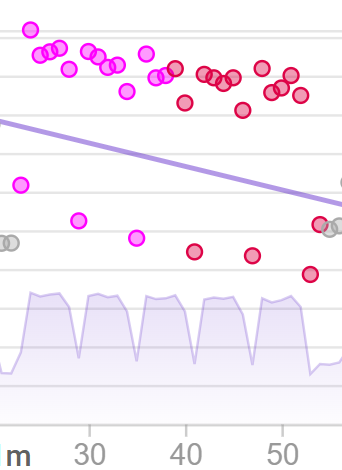
Hello
Great question.
I am sorry but really don’t use these types of intervals @ryan and @trevor have much more experience.
The pwhr that we are looking at here is all below the upper threshold, tracking this is likely very different than the picture you show.
Sorry I can’t be more helpful, I have just never really studied this or have a lot of experience.
Stev
@d_diston : a rising HR can be expected when working above MLSS. There are two components:
a) the slow component
b) HR adapting to the needs of the body. Whether the HR reaches a sealing depends on the duration of the interval and whether central fatigue kicks in before peripheral (muscle) fatigue
Muscles fatigue will show a strong decent of HR
About stretching:
If your athlete produces the same power:hr ratio during every interval AND the power output is equal across intervals, there is hardly any stretch. The training is ‘within the capabilities’ of the athlete. You should then extend the duration of the intervals, add more intervals, or increase the power prescription. (more power).
If the athlete cannot maintain the prescription anymore, fatigue has presented itself → stretched.
So, don’t just look at the ratio, but also the absolute values.
If fatigue kicks in before the prescribed session is over, you can prescribe this session a few more times until the power output and power:hr ratio are equal throughout the training.
@d_diston
Here is great example from this morning:
During the first 4 intervals you see a continuous rise of HR. After that HR shows a parabolic shape and has a lower peak. Power output (in this case measured as speed) also drops off from interval 5. Except for the last one, which can be explained by lower power output in the zone 3 section preceding that interval.
If I repeat this 3 or 4 times in the coming 2-3 weeks, i should be able the make the interval equal in absolute power output and power:hr. However, this session was was not capped and intended to go all-out. There, the power output will increase, the fatigue pattern probably not that much.
Would it be possible to ‘score’ latency/lag over subsequent, identical sessions to see if HR response is quicker to the onset of load?
For example: Week 1 - going from 150W to 300W, HR takes 90sec to stabilize @ 150 bpm; Week 2 - takes 60sec to stabilize @150 bpm.
Interesting question @d_diston . I have no idea actually.
I do know there are a lot of factors that influence that lag: the actual power applied while accelerating, fatigue in both heart and working muscles, temperature, ‘road conditions’ and perhaps the most important one: the instructions provided. i.e, should the athlete accelerate full power towards to target power/hr, slowly, moderate, and that highly depends on what you want to train (explosive power / top speed / durability).
possibly.
Might be me jumping around a bit or some confusion.
My 78-82% comes from doing a 1 hour time trial by heart rate - so 20-25m gradual build to 78-80% then ride max wattage with an 82% heart rate limit and check the 1 hour power. Below is an example of someone doing this a week after and Inscyd test (he did a very steady job of the heart rate but notice he was at 83% so slightly harder than I would have liked but steady and close)
And a picture of his Inscyd zones with Tempo outlined. Tempo target of 212 and the heart rate time trial 209 so about bang on.
Some of my thoughts are based off many athletes with similar power values and not many can ride steady state lactate for an hour above 250 watts.
Also keep in mind this heart test doesn’t work for everyone, and your two stages were pretty hard with the power spikes to get heart rate up.
I will say that athletes that I personally coach, who have a solid tempo ability have the same profile as you - lots of stages with the same power to heart rate ratio - others that I have seen do this test and have other data on have maybe 2 or 3 points where you have many so this is excellent.
Trying to really nail down what you are after from this test isn’t likely the best idea.
yes or see moxy data.
I have no idea - this is where we would be able to start to individualize your zones or thresholds.
It is possible to be equal to or above LT1 - I have seen ranges as close as 10 watts from LT1 to this tempo range I look for and as many as 35 watts difference. This is what makes the biggest deal to me when doing tempo - I really like to measure this.
Knowing the LT1 and Tempo accurately really helps get in a lot of work without building fatigue.
below are a few different athletes.
fat max 66% max heart rate / fat cho crossover 77% max heart rate
another athlete
fat max 71.7% max heart rate / fat carb crossover just below 84%
I would train these two athletes very differently.
Athlete with lower numbers would do a lot of training at fat cho crossover and some threshold work, and some sprint work.
Athlete with the higher numbers would do a more polarized approach, lost of work below fatmax (his tempo at fat cho crossover would be threshold work I would avoid this for this athlete) And training above threshold. This is really the profile I try and get for my athletes.
If your lactate curve is flattening and LT1 is going up there will be an improvement in fat cho metabolism for sure - you just wouldn’t know what that change is.
I like the Inscyd for the big picture, I use moxy monitor daily and a special warm-up to modify these daily training places with my athletes. So the daily warm-up and the actual workout itself allows me to see the trend they are headed. I am very interested in the daily status of people I coach.
There is nothing wrong with using lactate as long as YOU get good consistent readings. I have found that some people can do a great job taking their own lactates, and others not so much.
I look at a LOT of lactate tests, I would say around 50% of people taking their own lactates make mistakes…oddly enough just at the time when you need the number the most !
Sorry if this post is a little all over, but there isn’t really one answer.
I do Inscyd on my athletes every 2-3 months depending on what training phase they are in.
They all have a moxy, some have lactate as well.
Phew long one.
@steveneal have you ever looked at the Fat:Carb data field and used the crossover point in that?
I was on the trainer yesterday and at 219w I was burning more fat than carbs (just) but at 220w burning more carbs than fat (just) giving me a ‘crossover point’ of 219.5w I guess.
If I trained Fatmax then would I expect this crossover point (if it is indeed a crossover point) to increase i.e. go from 219.5w to 225w?
Sorry should of said - it’s a XERT garmin app
Hi,
I have been using xert a little bit before it went public. In fact Armando came to the gym I owned for a year. He also got tested on my metabolic cart.
I use xert for a number of different aspects of planning and training my clients, but let’s just say never for that data field.
